FREEPORT, Maine — I stepped out of the kitchen and into the L.L. Bean Hunting and Fishing store to learn fly tying.
I was lucky enough to work with their assistant manager and fly-tying expert Emily Bastian to make the "woolly bugger fly."
This one was particularly exciting and nerve-wracking for me because it was our first non-food segment. Plus, I don't know much about fishing, if we're being totally honest.
This entire process starts out how you'd think: with a hook. The hook was secured to a stand so we could wrap thread around it from the eye to the bend of the hook, making the base for the rest of our fly.
Next step is where it begins to look like a fly, and this is where each one becomes unique.
We took a green Marabou feather and secured it to the end of the hook. Use the fluffy edge that is away from the base of the feather. It should be measured out to equal the length of the hook. Once you get that length, you can trim some but not all the excess.
Now, hold the length of feather and the base of the hook at the same time, and wrap the thread around the feather. This will secure it to the hook while leaving most of the feather hanging off the end, so it moves freely in the water.
Then you can trim the rest of the excess feather that is closer to the head of the hook before wrapping whatever is left in the thread.
This is the same technique we are going to use to secure the rest of the elements of the fly.
Then we added the crystal flash for a bit of shininess that helps attract fish. It really catches the light and gives it a bit of sparkle. Measure and secure it the same way as the Marabou feather.
Next, add a black hackle feather and a piece of chenille to make up the body of the fly.
You don't want to cut these, but you do want to secure them the same way as the rest. Make sure they're tightly wound into the twine before using them to make the body.
At this point, the fly is nearly finished!
Take the chenille, and while keeping it tight, wrap it around the shank. Then secure it with the thread near the eye of the hook. Do the same with the hackle. To finish, tie a knot in the thread at the eye of the hook, and use a tiny bit of liquid cement to secure it.
And there it is! A woolly bugger fly finished and ready for some fly fishing.
Thank you so much to Emily Bastian and everyone at L.L. Bean for having me to the store and teaching me something new! I certainly never thought I would be fly tying, so this was a really exciting Myler Makes It for me.

